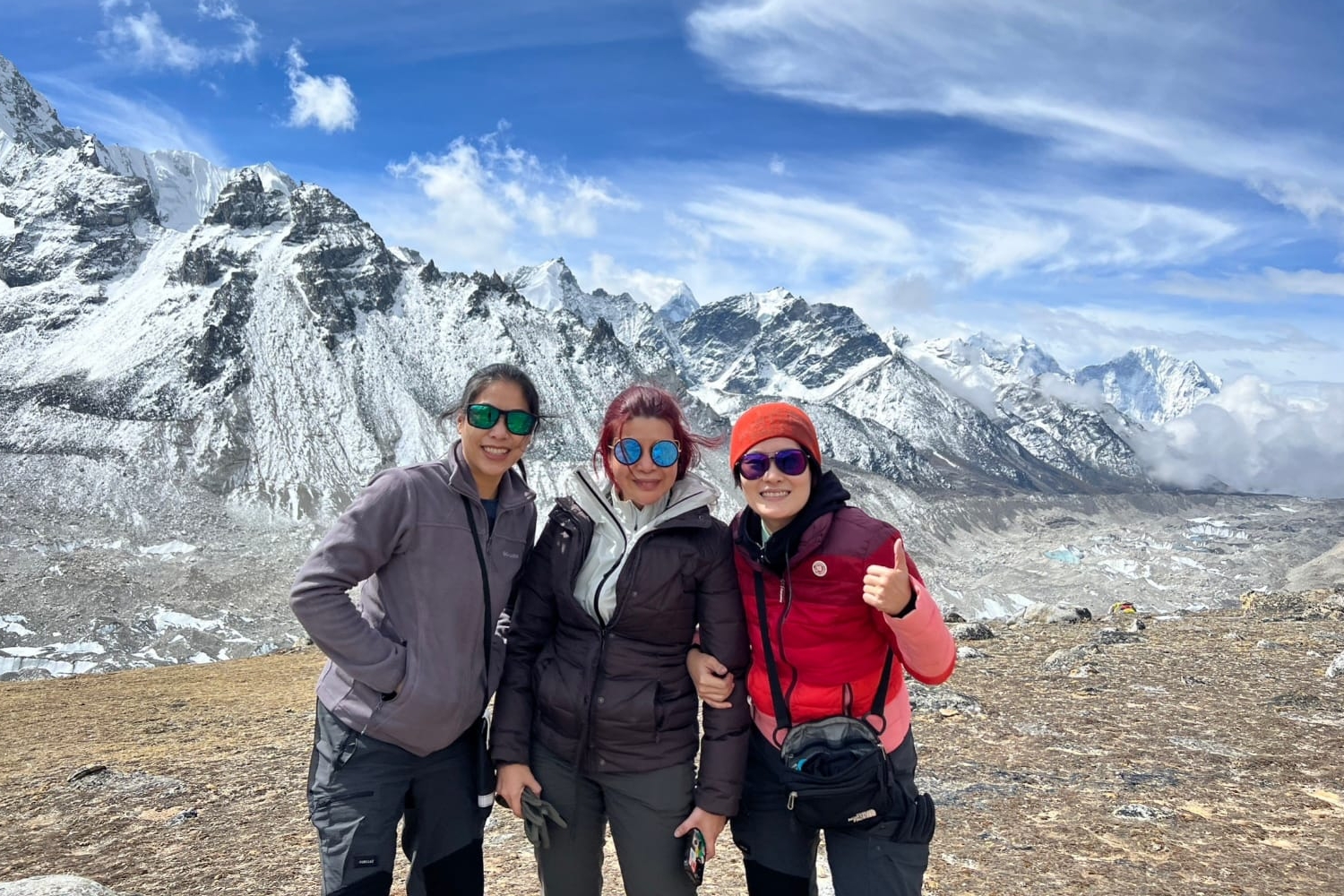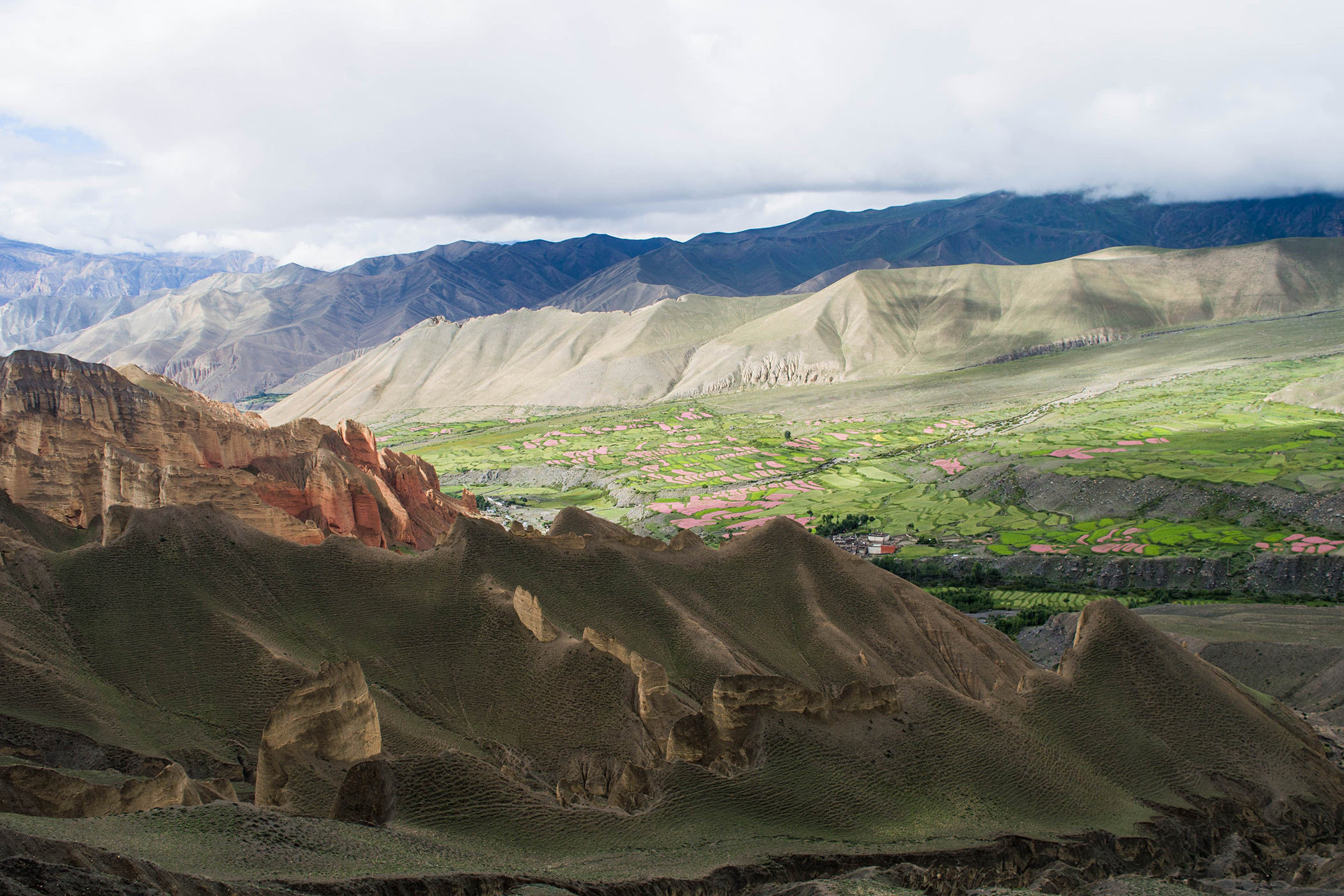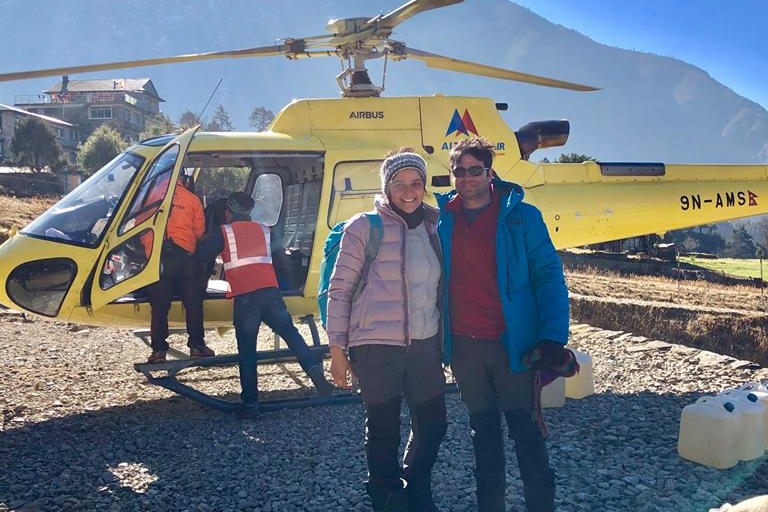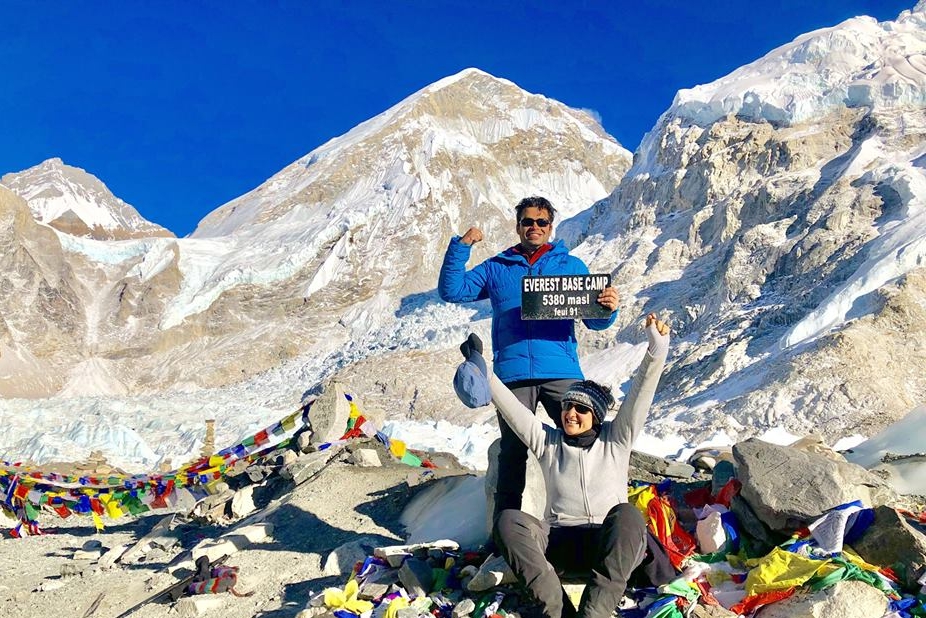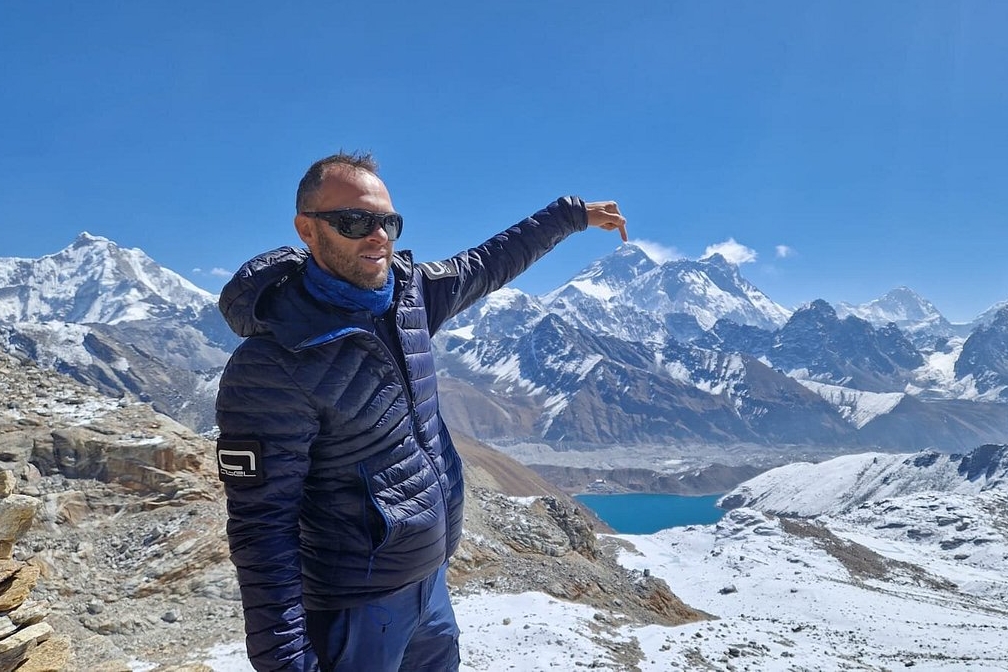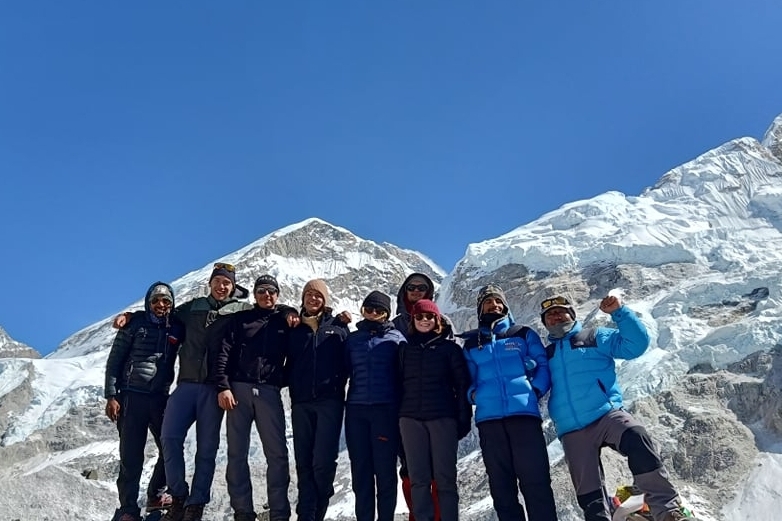The Everest Base Camp Trek is a popular trekking route in the Nepalese Himalayas, leading to the base camp of the world's highest mountain, Mount Everest (8848m). The trek offers a chance to explore the stunning scenery of the Himalayas, including snow-capped peaks, glaciers, and alpine forests, as well as to experience the unique culture of the Sherpa people. The trek typically starts from Lukla and passes through villages such as Namche Bazaar, Tengboche, and Dingboche before reaching the base camp. The trek can take anywhere from 10 to 21 days, depending on the itinerary, and requires physical fitness and acclimatization to the high altitude. The best time to go on the trek is from September to November and from March to May.
Everest Base Camp is the starting point for climbers attempting to reach the summit of Mount Everest, the highest peak in the world at 8,848 meters (29,032 feet) above sea level. It is located on the south side of the mountain in Nepal, and can be reached by a challenging trek through the Himalayan Mountains. The trek to the base camp is a popular adventure destination, attracting thousands of trekkers each year who come to experience the stunning natural beauty of the region and to see the iconic mountain up close. Along the way, trekkers will pass through traditional Sherpa villages, cross suspension bridges over fast-flowing rivers, and marvel at the views of some of the world's highest peaks. The base camp itself is a sprawling complex of tents and equipment, and serves as a hub for climbers as they make their final preparations for the ascent. Despite the challenges and difficulties of the journey, the experience of reaching the Everest Base Camp is considered by many to be one of the most rewarding and unforgettable adventures in the world.
Mount Everest, also known as Sagarmatha in Nepal and Chomolungma in Tibet, is the highest mountain in the world, standing at a height of 8,848 meters (29,032 feet). It is located on the border of Nepal and Tibet and is part of the Himalaya mountain range.
Everest has been a source of fascination and awe for centuries, and has been the goal of mountaineers from all over the world since its first successful ascent by Sir Edmund Hillary of New Zealand and Tenzing Norgay of Nepal in 1953. Since then, thousands of climbers have attempted to summit Everest, and it has become one of the most famous and iconic mountains in the world.
The ascent of Everest is a challenging and physically demanding endeavor, and requires a high level of physical fitness, technical climbing skills, and proper acclimatization to the high altitude. The standard climbing route to the summit of Everest follows the Southeast Ridge from Nepal, and involves climbing steep ice and snow slopes, as well as crossing several dangerous and exposed ridges.
The climbing season on Everest typically takes place between April and June, when the weather conditions are the most favorable. During this time, hundreds of climbers, sherpas, and support staff converge on the mountain, creating a busy and crowded base camp at the foot of the mountain.
The conditions on Everest are harsh and unforgiving, and climbers must be prepared for extreme cold, high winds, and low oxygen levels. The summit of Everest lies above the so-called "Death Zone," which is defined as any area above 8,000 meters (26,247 feet), where the atmospheric pressure and oxygen levels are so low that it is not possible for human life to survive for an extended period of time.
Despite its challenges, the ascent of Everest continues to be a popular and highly sought-after goal for mountaineers from all over the world. The experience of standing on the highest point on earth is considered by many to be one of the ultimate achievements in the world of mountaineering.
In addition to its mountaineering appeal, Mount Everest also holds a special place in the hearts and minds of the people of Nepal and Tibet. It is considered a sacred mountain by the Sherpa people of Nepal and is revered as the "Mother of the Universe" by the Tibetan people.
In conclusion, Mount Everest is an iconic and awe-inspiring mountain that has captivated the imagination of people all over the world. It is a challenging and demanding ascent, but the rewards of standing on the highest point on earth make it a journey that will stay with you for a lifetime.
The best time to do the Everest Base Camp Trek is during the spring (March to May) and autumn (September to November) seasons. During these months, the weather is clear, the skies are blue, and the views of the mountains are spectacular. Additionally, the temperatures are moderate, making it easier to trek comfortably.
However, it is important to note that the weather in the mountains can be unpredictable and can change quickly, so it is always best to be prepared for any conditions. The monsoon season, from June to August, is not ideal for trekking due to heavy rain and poor visibility. The winter season, from December to February, can also be challenging due to cold temperatures and the possibility of snow and ice on the trail.
The trek from Lukla to Everest Base Camp is a popular and challenging adventure in the Nepalese Himalayas. The journey typically takes about 10 to 14 Day Everest Base Camp Trek and involves a strenuous hike through rugged terrain and altitudes reaching up to 5,364 meters (17,598 feet) at Gorakshep, near the base camp. Along the way, trekkers will pass through traditional Sherpa villages, cross suspension bridges over fast-flowing rivers, and marvel at the stunning views of some of the world's highest peaks, including Mount Everest itself. The trek requires a good level of physical fitness, acclimatization to the high altitude, and a proper gear. However, for those who make the effort, the reward is an unforgettable experience in one of the world's most awe-inspiring natural environments.
Accommodation during the Everest Base Camp Trek is typically in basic tea houses or lodges. These facilities offer basic dormitory-style rooms with shared bathrooms, and sometimes offer hot showers for an additional fee. Many of the tea houses also serve meals, which usually consist of traditional Nepalese and Tibetan dishes, such as dal bhat (lentil soup and rice), momos (dumplings), and various types of noodle soup. Most trekkers will also have the opportunity to purchase snacks, energy bars, and other food items along the way. Some of the tea houses offer more comfortable and better-equipped rooms for a higher price, and it's recommended to book in advance, especially during the peak trekking season from September to November. It's important to note that the quality of accommodation and food can vary greatly along the trek, but trekkers can expect basic and functional facilities in most places.
The vegetation in the Everest region varies greatly with elevation and is influenced by the harsh climate conditions. At lower elevations, the landscape is covered in dense forests of rhododendron, oak, and pine trees. As the elevation increases, the forests give way to scrublands and alpine meadows. Above the tree line, at around 4,000 meters (13,123 feet), there is very little vegetation, and the landscape is dominated by rocks, glaciers, and snowfields. In some areas, hardy plant species such as juniper, Himalayan birch, and blue poppies can be found growing in sheltered pockets. Overall, the vegetation in the Everest region is unique and adapted to the extreme environmental conditions, providing critical habitats for a variety of wildlife species and serving as an important resource for the local communities.
The cost of the Everest Base Camp trek can vary greatly depending on a variety of factors, including the level of comfort desired, the length of the trek, the time of year, and the services included. On average, a budget-friendly trek to Everest Base Camp can cost between $1,500 to $2,500 per person for a basic package, which typically includes transportation to and from Lukla, accommodations in tea houses or lodges, meals, and a guide and porter. More premium packages can cost upwards of $3,500 or more and may include private transportation, better-equipped lodges, and additional services such as helicopter rescue insurance and personal gear. It's important to note that prices may also vary depending on the time of year and demand, with prices tending to be higher during the peak trekking season from September to November. Additionally, trekkers should budget for expenses such as visas, travel insurance, and personal gear, as well as any additional activities or services they may want to experience along the way.
The Everest Base Camp trek is a challenging hike that requires a good level of physical fitness and preparation. While the trek is not technically difficult, it does involve several days of hiking at high altitudes, often for several hours at a time, over rugged terrain. To prepare for the trek, it is recommended to engage in regular physical exercise, such as running, cycling, or hiking, for several months prior to the trip. This will help build endurance and strength, and improve cardiovascular fitness.
Travel insurance is highly recommended for the Everest Base Camp trek, as the region is remote and the trek can be physically demanding. A good travel insurance policy will provide coverage for unexpected medical expenses, evacuation, trip cancellations, and lost or stolen gear, among other things. When choosing a travel insurance policy, it is important to select a policy that provides comprehensive coverage, including high-altitude trekking and adventure sports. Some policies may exclude coverage for activities such as climbing or mountaineering, so it's important to carefully read the policy details and understand what is covered and what is not.
In addition to travel insurance, it is also a good idea to carry a comprehensive first-aid kit, as well as any necessary medications and other personal items, such as sunscreen, insect repellent, and water purification tablets. Trekkers should also be prepared for unexpected weather conditions and be equipped with warm, waterproof clothing and gear. With proper planning and preparation, a trek to Everest Base Camp can be a safe and rewarding adventure, and travel insurance can provide peace of mind and protection in the event of an emergency.
1. Experience the challenge of climbing one of the world's tallest peaks.
2. Explore the unique landscape, culture and traditions of the Himalayas.
3. Gain personal fulfillment and a sense of accomplishment.
4. See stunning views of the Himalayas and surrounding landscape from the summit of Mount Everest.
5. Connect with nature and escape from the daily hustle and bustle of city life.
6. Meet other trekkers from all over the world and make new friends.
7. Learn about the history and geography of the region.
8.Contribute to the local economy through responsible tourism practices.
The choice between solo or group trekking in the Everest region depends on personal preference, experience and comfort level.
2. A unique and personal experience.
3. An opportunity to challenge yourself and push your limits.
1. Safety in numbers, particularly in case of an emergency.
2. A sense of community and camaraderie with fellow trekkers.
3. An opportunity to make new friends and share the experience.
4. More affordable as costs can be shared.
5. More support from experienced guides and porters.
Ultimately, the choice between solo or group trekking will depend on the individual's level of experience, comfort with navigating remote terrain, and personal preference.
1. Eligibility: Most nationalities, including citizens of the United States, United Kingdom, and Australia, are eligible for a Nepal visa.
2. Types of visa: Nepal offers a tourist visa, which can be obtained for multiple entry for 15 or 30 days, or for 90 days.
3. How to apply: Visas can be obtained upon arrival at Tribhuvan International Airport in Kathmandu, or at a Nepalese embassy or consulate abroad.
4. Required documents: A passport valid for at least 6 months and a recent passport-sized photograph are required to obtain a visa.
5. Fee: The fee for a 15-day multiple entry tourist visa is USD 25, a 30-day multiple entry visa is USD 40, and a 90-day multiple entry visa is USD 100.
6. Extension: If you need to stay longer in Nepal, you can extend your visa by paying a fee and submitting the necessary documents at the Department of Immigration in Kathmandu.
1. Everest Base Camp Trek: This trek takes you to the base camp of the world's highest mountain, Mount Everest.
2. Gokyo Lakes Trek: This trek takes you to the serene Gokyo Lakes and offers panoramic views of Everest, Makalu, and Cho Oyu.
3. Everest View Trek: This trek takes you to the Tengboche Monastery and offer best way to explore Everest region without the risk of altitude sickness.
4. Jiri to Everest Base Camp Trek: This is a longer and more challenging trek that starts in the town of Jiri and ends at the Everest Base Camp.
5. Three Passes Trek: This is a strenuous trek that takes you over three high passes - Kongma La, Cho La, and Renjo La - offering stunning views of the Himalayas.
All of these treks require some level of physical fitness and can be done with the help of a guide and porter. The best time to trek in the Everest region is from September to November and from March to May.
Namche Bazaar is a Sherpa town located in the Solu-Khumbu region of Nepal. It is a popular stopover point for trekkers and mountaineers who are en route to the Everest Base Camp. Namche Bazaar is located at an altitude of 3,440 meters and is surrounded by stunning mountain views, including Mount Everest, Lhotse, and Nuptse.
The town offers a variety of amenities for trekkers, including restaurants, lodges, internet cafes, and souvenir shops. It is also home to a weekly market that attracts traders from nearby villages, providing a glimpse into the local culture and traditions.
Namche Bazaar is an important stopover point as it allows trekkers to acclimatize to the high altitude before continuing their journey to higher elevations.
Acclimatization is a crucial process for trekkers and mountaineers in the Everest region, as the high altitude can cause altitude sickness. Acclimatization involves gradually adjusting to the thinning air at high elevations by taking sufficient rest and reducing physical activity.
The recommended acclimatization schedule for the Everest region is to increase your altitude by no more than 300-500 meters per day and to spend at least one night at each elevation before ascending further. This gives the body sufficient time to adjust to the changing conditions.
It is also recommended to stay hydrated and to consume high-carbohydrate foods to help the body acclimatize. If you experience symptoms of altitude sickness such as headache, nausea, dizziness, or loss of appetite, it is important to descend to a lower altitude immediately.
By following proper acclimatization techniques, you can reduce the risk of altitude sickness and increase your chances of safely reaching your desired destination in the Everest region.
Acclimatization hikes are short side trips that trekkers and mountaineers can take during their journey in the Everest region to help their bodies adjust to the high altitude. Here are a few popular acclimatization hikes in the region:
1.Everest View Hotel Hike: A short hike to the Everest View Hotel, which offers panoramic views of the surrounding mountains, including Ama Dablam, Everest, and Nuptse.
2.Dingboche Hike: A hike to the village of Dingboche, which offers stunning views of the surrounding peaks, including Island Peak and Lhotse.
3.Chhukung Hike: A hike to the village of Chhukung, which offers excellent views of the nearby peaks, including Ama Dablam, Makalu, and Lhotse.
4.Kalapatthar Hike: A steep hike to Kalapatthar, which offers an unobstructed view of Mount Everest and the surrounding peaks.
These hikes can take anywhere from a few hours to a full day and can be done with the help of a guide and porter. The best time to do acclimatization hikes is in the morning, as the air is clearer and the views are better. By taking these hikes, you can help your body adjust to the high altitude and reduce the risk of altitude sickness.
1.Prevents Altitude Sickness: Acclimatization helps to reduce the risk of altitude sickness, which can range from mild symptoms like headache and nausea to severe and life-threatening conditions like high altitude cerebral edema (HACE) and high altitude pulmonary edema (HAPE).
2.Better Performance: By allowing the body to adapt to the reduced oxygen levels, acclimatization can help improve physical performance at high elevations.
3.Increases Enjoyment: Acclimatization can also make the trekking or climbing experience more enjoyable by reducing the risk of altitude sickness and allowing people to better appreciate the natural beauty of their surroundings.
4.Safe and Successful Trek: Proper acclimatization is essential for a safe and successful trek or climb. By taking the necessary time to acclimate, people can reduce the risk of altitude sickness and other related health problems.
In conclusion, acclimatization is an important aspect of high-altitude trekking and climbing and should not be overlooked.
1. Mount Everest (8848m)
2. Lhotse (8516m)
3.Nuptse (7861m)
4.Ama Dablam (6812m)
5.Pumori (7145m)
6.Thamserku (6623m)
7.Kwangde (6011m)
8. Kangtega (6783m)
9.Tawache (6501m)
These mountains offer stunning views and make for a spectacular backdrop during the trek.
The Sherpa people are an ethnic group of Nepalese origin who live in the Solu-Khumbu region of Nepal, near Mount Everest. They have a rich cultural heritage and are known for their exceptional mountaineering skills, which have made them an integral part of the climbing community on Mount Everest and other Himalayan peaks.
The Sherpas have a deep spiritual connection to the mountains and have a long history of involvement in the trade and transportation of goods between Nepal and Tibet. They have also developed a unique set of skills and knowledge related to high-altitude mountaineering, which has made them sought after by climbers and expedition companies from all over the world.
In recent decades, the Sherpa people have become a major force in the Nepalese tourism industry, with many Sherpas working as guides, porters, and support staff on climbing expeditions and trekking tours in the Himalayas. Despite their valuable contributions to the industry, however, many Sherpas still face challenges related to poverty, lack of education, and limited access to healthcare and other essential services.
The Sherpa culture is rich and diverse, with a strong tradition of storytelling, music, and dance. Sherpa communities are closely knit and place great importance on family and community ties. They have a deep respect for the natural environment and a strong spiritual connection to the mountains, which is reflected in their daily lives and cultural practices.
One of the most important aspects of Sherpa culture is their deep respect for the mountain gods and their belief in the spiritual power of the mountains. This belief is closely tied to the Sherpa people's traditional way of life, which has been shaped by their close relationship with the mountains for centuries.
Despite the challenges that the Sherpa people face, they remain deeply connected to their culture and traditions, and continue to play a vital role in the Nepalese tourism industry and in the preservation of the unique and rich cultural heritage of the Solu-Khumbu region.
In conclusion, the Sherpa people are an integral part of the fabric of Nepalese society and the mountaineering community in the Himalayas. Their rich cultural heritage, spiritual connection to the mountains, and exceptional mountaineering skills make them a unique and valuable part of the world's cultural and natural heritage.
Everest base camp trek requires a Khumbu Pasang Lhamu Rural Municipality Entrance permit and a Sagarmatha National Park Entry permit. We have included both permit costs in our Everest base camp trek cost.
Khumbu Pasang Lhamu Rural Municipality Entrance permit cost: Nrs 2000 per person
Sagarmatha National Park Entry permit cost: Nrs 3000 per person
The trail conditions for the Everest Base Camp Trek can vary depending on the time of year and the specific route taken. In general, the trail is well-trodden and well-marked, but it can still be challenging due to the altitude and the rugged terrain.
1.Steep ascents and descents: The trail includes steep sections that can be strenuous, especially at high altitude.
2.Rocky and uneven terrain: The trail is often rocky and uneven, requiring careful footing and balance.
3.Crossings of rivers and streams: The trail crosses several rivers and streams, and it is essential to take care when crossing these, especially during the rainy season when water levels can be high.
4.Snow and ice: Snow and ice can be present on the trail, especially at higher elevations, and trekkers should be prepared for winter conditions.
5.Altitude: The trail reaches a maximum elevation of 5,364 meters (17,598 feet) at Gorakshep, and trekkers will need to acclimatize properly to avoid altitude sickness.
Overall, the trail conditions for the Everest Base Camp Trek can be challenging, but the reward of reaching the base camp and experiencing the stunning mountain scenery make it a memorable and rewarding experience.
Kalapatthar is a popular viewpoint located in the Solu-Khumbu region of Nepal, near Mount Everest. The name Kalapatthar literally means "black rock" in Nepalese, and it is one of the best places in the region to view the sunrise.
From Kalapatthar, it is possible to see panoramic views of the surrounding mountains, including the iconic peaks of Mount Everest, Lhotse, Nuptse, and many others. The sunrise over these peaks is truly a breathtaking sight, and one that many trekkers and mountaineers come to experience for themselves.
The best time to visit Kalapatthar is during the pre-monsoon season, from late February to May, when the weather is clear and dry. During this time, the skies are often crystal clear, allowing for stunning views of the surrounding peaks and valleys.
To reach Kalapatthar, it is necessary to trek from the nearby village of Gorak Shep, which can take several hours depending on your pace. The trek is strenuous, and requires a good level of physical fitness, but the effort is well worth it for the stunning views that await at the top.
Overall, the sunrise from Kalapatthar is an unforgettable experience and a must-visit destination for anyone interested in trekking or mountaineering in the Himalayas. Whether you are a seasoned trekker or a first-time visitor to the region, the sunrise from Kalapatthar is an experience that you will never forget.
The Everest Base Camp Helicopter Tour is a breathtaking way to experience the beauty of Mount Everest and the surrounding Himalayan range. The tour is an alternative to the traditional trekking route, offering visitors a unique and thrilling perspective on the world's highest mountain. Here is an overview of what the tour entails:
1.Departure from Kathmandu: The tour typically starts with a flight from Kathmandu to Lukla, a small town in the Solu-Khumbu region of Nepal. From there, a helicopter takes visitors directly to the base camp of Mount Everest.
2.Scenic Flight: The flight to the base camp offers stunning views of the surrounding mountain ranges, including peaks such as Ama Dablam, Nuptse, and Lhotse. During the flight, visitors can admire the stunning landscapes and take in the panoramic views from the comfort of the helicopter.
3.Visit to Base Camp: Upon arrival at the base camp, visitors are given time to take in the surroundings, take photos, and explore the area. The base camp sits at an altitude of 5,364 meters (17,598 feet) and provides a dramatic backdrop for this once-in-a-lifetime experience.
4.Return Flight: After spending some time at the base camp, the helicopter returns to Lukla, where visitors can continue their tour or fly back to Kathmandu.
5.Aerial View of the Khumbu Glacier: On the return flight, visitors are treated to an aerial view of the Khumbu Glacier, one of the largest glaciers in the world and the source of the mighty River Ganges.
6.Experience with a Guide: The tour is typically conducted with a professional guide who can provide insights into the history, culture, and geography of the region.
7.Short Duration: The entire tour can be completed in a single day, making it an ideal option for those who are short on time or who want to experience the beauty of Mount Everest without the physical challenge of a trek.
Overall, the Everest Base Camp Helicopter Tour offers a once-in-a-lifetime experience for visitors, providing a unique and thrilling perspective on Mount Everest and the surrounding Himalayan range. With its breathtaking scenery, short duration, and convenient departure from Kathmandu, the tour is a must-do for anyone looking to experience the beauty of the highest mountain in the world.
Mount Everest is the highest mountain in the world, and its iconic peak has long been a source of fascination and inspiration for people all over the world. This is one of the main reasons why Everest trekking has become the most famous trekking activity in the world.
The opportunity to visit the base camp of Mount Everest, located at an altitude of 5,364 meters, is a once-in-a-lifetime experience for many people. Trekking to the base camp provides a chance to witness the majesty of the mountain up close, as well as to explore the surrounding landscape and interact with the local Sherpa communities.
Everest trekking also offers some of the most breathtaking mountain scenery in the world, with panoramic views of the Himalayan peaks, glaciers, and valleys. Along the way, trekkers have the opportunity to experience the unique culture and traditions of the Sherpa people, as well as to learn about the history of mountaineering on Everest.
Additionally, the Everest trek is accessible to people of all fitness levels, and with proper preparation, it can be a challenging but rewarding experience for anyone. There are several trekking routes that lead to the base camp, with varying levels of difficulty and duration, so there is something for everyone.
In conclusion, the combination of the world's highest mountain, stunning mountain scenery, unique cultural experiences, and the opportunity for personal challenge and growth are the reasons why Everest trekking is the most famous trekking activity in the world. Whether you are a seasoned trekker or a first-time visitor to the region, a trek to the base camp of Mount Everest is an experience that you will never forget.le of all fitness levels, and with proper preparation, it can be a challenging but rewarding experience for anyone. There are several trekking routes that lead to the base camp, with varying levels of difficulty and duration, so there is something for everyone.
In conclusion, the combination of the world's highest mountain, stunning mountain scenery, unique cultural experiences, and the opportunity for personal challenge and growth are the reasons why Everest trekking is the most famous trekking activity in the world. Whether you are a seasoned trekker or a first-time visitor to the region, a trek to the base camp of Mount Everest is an experience that you will never forget Nepal adventure Pilgrimage trek .
1. Fitness: The Everest Base Camp Trek is a physically demanding trek that requires a good level of fitness. It is recommended to train for several months before embarking on the trek, including hiking, running, and weight training.
2.Permits: You will need to obtain a TIMS card (Trekkers' Information Management System) and a Sagarmatha National Park Permit to trek to the Everest Base Camp. Your trekking agency can help you obtain these permits.
3.Acclimatization: It is important to follow a proper acclimatization schedule during the trek, as the high altitude can cause altitude sickness. It is recommended to increase your altitude by no more than 300-500 meters per day and to spend at least one night at each elevation before ascending further.
4.Clothing and Equipment: Make sure to pack warm clothing and gear, as the temperature can drop significantly at high elevations. You will also need a good quality sleeping bag, down jacket, and sturdy trekking boots.
5.Food and Water: It is important to stay hydrated during the trek, and it is recommended to drink at least 3 liters of water per day. Most teahouses along the trekking route offer a variety of Nepalese and continental dishes, but it is also a good idea to carry some energy bars and snacks for the trail.
6.Health: It is recommended to visit a doctor and get a check-up before embarking on the trek, especially if you have a pre-existing medical condition. You should also bring along basic first-aid supplies and any necessary medication.
By following these tips and being well-prepared, you can ensure a safe and enjoyable experience while trekking to the Everest Base Camp.
When you arrive at the Tribhuvan international airport terminal, our airport team will be there waiting to greet you. They'll assist you with your luggage and take you to your hotel. Once you've had some time to rest, we'll schedule a meeting with the core team members at our Nepal Adventure Pilgrimage office. Here, we'll introduce you to your trek leader and go over any final preparations needed for your upcoming journey. With the evening free, feel free to explore the lively streets of Thamel and pick up any last-minute items you may need.
Trek distance: 6.2 km/3.8 miles
Duration: 35 minutes flight & 3 hours trek
Accommodation: Pine Forest
Meals: Breakfast, lunch & dinner
Rise and shine early to experience a thrilling flight from Kathmandu airport to Lukla airport. This short flight offers breathtaking views of the surrounding landscapes. Upon arriving at the Tenzing Hillary Airport, we'll be joined by our porters, and the Everest base camp trekking begins. The trail from Lukla drops down to Phakding village where we'll be spending the night.
The first leg of the journey is an easy downhill walk from Lukla, which takes us through lush forests along the Dudh Koshi river. Along the way, we'll pass by Cheplung village (2,660 m) and Thado Koshi Gaon (2,580 m) before finally arriving at Phakding village. As we trek, we'll cross several ridges and catch views of stunning mountain peaks like Kusum Kangguru and Kongde Ri.
Trek distance: 7.4 km/4.6 miles
Duration: 6 hours
Accommodation: The Hotel Bodhi
Meals: Breakfast, lunch & dinner
Once we depart from Phakding village, the trail leads us through vibrant rhododendron and magnolia forests to Toktok (2,760 m). After passing Bengkar village (2,630 m), we'll cross two bridges, including the long Hillary Bridge, which is quite long, to reach Monjo (2,835 m). At Monjo, we'll register our permits at the police check post and continue our trek through lush forests.
As we continue trekking forward, we'll cross several suspension bridges and small settlements before finally arriving at Namche Bazaar. The trail does get steep as we begin to approach Namche Bazaar, but this challenging ascent is worth it for the breathtaking view of Everest that welcomes us upon arrival.
Duration: 4-5 hours
Accommodation:The Hotel Bodhi
Meals: Breakfast, lunch & dinner
To properly acclimate to the altitude, we'll be taking a day off in Namche Bazaar. Early in the morning, we'll embark on an impressive hike to the Everest View Hotel via Syangboche Airstrip, which is situated above Namche Bazaar. During this hike, we'll be treated to stunning views of many towering mountains, such as Everest, Thamserku, Ama Dablam, Lhotse, Nuptse, Taboche, Khumbila, and more. The Everest View Hotel is not only one of the highest luxury hotels in the world but also holds the Guinness World record.
For those who want to continue the hike, we'll also have the option to visit the Khumjung monastery, one of the oldest monasteries in the Khumbu region. After our hike, we'll descend down to Namche Bazaar to spend the rest of the day exploring the village. There are plenty of things to do in Namche Bazaar, including visiting souvenir shops, cafes, museums, and more.
Trek distance: 9.2 km/5.7 miles
Duration: 5 hours
Accommodation:Himalayan inn
Meals: Breakfast, lunch & dinner
Leaving Namche Bazaar, we'll be ascending along the verdant foothills to Kyangjuma (3,550 m). Along the way, we'll be treated to some phenomenal views of the surrounding mountains. The trail follows a winding uphill route before descending to Phungi Thanga (3,250 m). After crossing a bridge, we'll walk through lush forests and begin our ascent towards Tengboche village. Once we reach Tengboche, we'll be rewarded with some truly excellent views of Everest, Lhotse, Nuptse, and Ama Dablam from the back of the Tengboche monastery.
Trek distance: 12 km/7.45 miles
Duration: 5 hours
Accommodation: Hotel Good Luck
Meals: Breakfast, lunch & dinner
We'll be waking up early on this day to witness a stunning sunrise. After breakfast, we'll leave Tengboche and start our descent through the lush rhododendron forest towards Deboche (3,320 m). Along the way, we may spot musk deer, blue sheep, and monal. After crossing a suspension bridge over Imja Khola, we'll pass by Pangboche village (3,930 m).
Continuing our trek through lush rhododendron forests, we'll cross another bridge before the trail takes us through Shomare (4,010 m) and Orsho (4,190 m). We'll then walk along the Imja Khola river and gradually ascend towards Dingboche village.
Duration: 4-5 hours
Accommodation: Hotel Good Luck
Meals: Breakfast, lunch & dinner
Taking the second day off in Dingboche village is necessary for proper acclimatization and a more enjoyable trekking experience ahead. In the morning, we'll take a hike to Nagarjuna Hill, which offers breathtaking views of the surrounding mountains, including Lobuche Peak, Lhotse, Nuptse, Cholatse, Kangtega, Ama Dablam, and more. After the hike, we'll spend the rest of the day relaxing and exploring the village, getting to know the locals and their way of life.
Trek distance: 8.5 km/5.2 miles
Duration: 5-6 hours
Accommodation: Motherearth
Meals: Breakfast, lunch & dinner
From Dingboche, we ascend on a steep path that leads to a ridge that separates the Imja and Khumbu valleys. The trail offers stunning panoramic views of the surrounding peaks, including Ama Dablam, Lhotse, and Nuptse. As we climb higher, we pass by a series of chortens and prayer flags that mark the path to Thukla, where we'll take a short break.
From Thukla, the trail becomes more challenging, with a steep ascent up to Dughla Pass (4,830 m). The pass offers breathtaking views of the surrounding mountains, including Pumori, Lingtren, and Khumbutse. As we descend from the pass, we pass by a memorial dedicated to climbers who have lost their lives on Everest.
After the memorial, the trail continues to Lobuche village, passing by some of the most dramatic scenery on the trek. The mountains become more prominent, with views of rocky hills and massive glaciers.
Trek distance: 15 km/9.32 miles
Duration: 8 hours
Accommodation: Hotel Himalayan Inn
Meals: Breakfast, lunch & dinner
The trek ahead of us today promises to be both challenging and rewarding. We lace up our boots and set out early, ready to tackle the rugged terrain that awaits us. As we make our way along the rocky trail, we gradually ascend along the Khumbu Glacier, taking in the stunning views of the surrounding mountain ranges. Along the way, we’ll pass by a research center called Pyramid.
The trail continues to climb as we make our way toward Gorak Shep, navigating our way through glacial moraines and streams. Our ultimate destination for the day is the world-famous Everest Base Camp, where we'll spend some time taking in the awe-inspiring sight of the Khumbu Icefall. After a long day of trekking, we'll trek back to our accommodations in Gorka Shep for a well-deserved rest.
Trek distance: 9.6 km/6 miles
Duration: 6 hours
Accommodation: Eco Lodge
Meals: Breakfast, lunch & dinner
The highlight of our trek is undoubtedly the hike to Kala Patthar, a vantage point located high above the village of Gorak Shep. We rise early in the morning, eager to witness the majestic Himalayan range as the sun rises above the mountains. The ascent to Kala Patthar is steep and rugged, but the incredible views of towering snow-capped peaks make the effort worthwhile.
After taking in the breathtaking 30-degree view from this lofty vantage point, we begin our descent back to Gorak Shep. Retracing our steps, we make our way back towards Lobuche and cross the Dughla Pass once again. Along the way, we pass through small settlement areas before finally arriving at Pheriche village, where we'll rest for the night.
Trek distance: 17.7 km/10.9 miles
Duration: 7-8 hours
Accommodation:The Hotel Bodhi
Meals: Breakfast, lunch & dinner
As our trek nears its end, we begin our descent from Pheriche towards Namche Bazaar. The route takes us back through familiar territory, retracing our steps past Pangboche village and crossing several bridges over the glistening waters of the Dudh Koshi river. We pass through small villages, taking in the sights and sounds of the local people and their way of life.
The trail winds its way through lush rhododendron forests, providing a stunning backdrop for our journey. Eventually, we arrive at Tengboche village and begin descending steadily towards Phungi Thanga, from where we continue our winding journey along the Dudh Koshi river before finally arriving at our destination, the bustling town of Namche Bazaar.
Trek distance: 13.6 km/8.3 miles
Duration: 8 hours
Accommodation: The Nest
Meals: Breakfast, lunch & dinner
As we bid farewell to the beautiful town of Namche Bazaar, we’ll begin trekking toward Lukla. The descent from Namche Bazaar is steep and challenging, but the stunning views of the surrounding mountain ranges make it all worthwhile. We cross a bridge and make our way through dense forests, following the meandering trail as it winds its way through the alpine woodlands and small villages.
Along the way, we'll cross several suspension bridges, taking in the breathtaking views of the rushing rivers below. Upon arriving in Lukla, we'll have a chance to reflect on our incredible journey and celebrate our accomplishments with the locals over some well-deserved drinks and traditional meals.
Duration: 35 minutes flight
Accommodation: Hotel The Nest
Meals: Breakfast & farewell dinner
As our unforgettable journey to Everest Base Camp comes to an end, we bid farewell to the majestic mountains and take an early morning flight back to Kathmandu. The flight offers one last chance to soak in the breathtaking views of the Himalayas from above. Upon arrival in Kathmandu, our team will escort you to your hotel, where you'll have a full leisure day to unwind and explore the city. In the evening, we'll meet for a farewell dinner and celebrate the monumental achievement of reaching Everest Base Camp.
Our airport team will assist with your check-out and take care of your luggage to ensure a smooth departure. Whether you're headed home or continuing your travels elsewhere, we'll make sure you leave Nepal feeling well taken care of and with memories to cherish for a lifetime.
Great tour, great guide. I decided to do the Everest Base Camp tour spontaneously and booked a night before leaving the next day. Our guide Anil picked us up from the airport and took care of everything. He made me feel comfortable and safe. We had a lot of fun and a great time. The landscape was amazing even though it was really cold at night it was worth it. Always again!
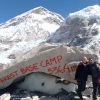
The quality of service of Nepal Adventure Pilgrimage Treks and Expedition is perfect. It was the second year in sequence when we ordered permits, transfers and service of porters for trekking. The work is clear done, everyone is very friendly and responsive. Even during the track they always kept in touch with us, finding out if everything was good with us. Thanks again! Recommend.
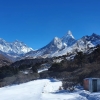
Great experience from end to beginning. We came to Kathmandu with no booking so we looked around for agencies. It was when we were buying gear that the owner of the shop contacted Anil, the manager of the company I’m reviewing, and he offered us to match competition prices, he lend us some raincoats we were missing, and even kept our bags during the whole trip to Everest. He got us a guide from Lukla, the first town in the trek, and was an amazing guide, very friendly and humble, we’re still missing him, Kamal. During the trip we got very good lodges and food. The guide was not strict and he would no rush to get to the top. Decisions during the trek were made by us and the guide and by no means we were forced to do anything if we did not want to. Also Anil was always trying to contact us to know how the trek was going and by the end of the trip he took us to a great dinner back in Kathmandu. He even helped us to get a flight to Thailand, our next destination, when we were leaving Nepal. In short, Anil and Kamal’s service exceeded our expectations :) Thanks for everything!!
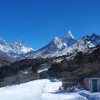
We had the pleasure of having Anil as our guide to EBC in Oct 2022. He's extremely knowledgeable with the trek up to base camp. Looked after our group very well. Anil and the porters went above and beyond to look after us. We really enjoyed our trek. Anil is extremely friendly he makes sure we have what we needed and more. He also a funny and cheeky guy which made our trek more enjoyable. Thank you for looking after us Mr Anil Dhakal and his company ! You've been great and really enjoyed our trip. Until next time.
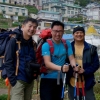
I booked an Everest Base Camp trip with Anil in Oct 2022. Weather was bad for flying at the start, so Anil came up with a nice plan to extend the trip with 4 days extra hiking. Everything went smoothly. My guide, Bhabanath was really experienced and helpful. Good thing, because sleeping accomadations at this busy time are quite difficult to secure without careful planning. Great time, great weather and lots of fun. Thank you Anil and Bhabanth. if you go to Nepal please you have to choose Nepal Adventure Pilgrimage Trek .
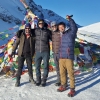
The trek was pretty challenging. It was spanning for about 14 days.The trek was very scenic, but the path was tough.The company provides all the information in an easy to understand.The trek itself was made very fun, exciting, and very memorable by a professional guide who made sure all needs were met without issue. A big thank you to our guide and Anil of Nepal Adventure Pilgrimage Treks and Expedition Pvt. Ltd for making our journey wonderful. I Highly Recommend anyone interested.
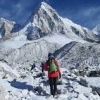
This trip was very well organized. We were set up with guides and porters that were very experienced, helpful, and trust worthy. This was a once in a lifetime adventure for us all. The whole trek is a pleasure to hike and I enjoyed every moment of it. Thank you, Nepal Adventure Pilgrimage Treks and Expedition Pvt. Ltd Team, for arranging this Wonderful trip for us. We highly recommend it
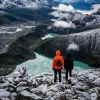
I search Everest Base Camp Trek internet found Nepal Adventure Pilgrimage Treks .Then I booked EBC trek.They provides us best service.The guides and porters behavior was so good.Thanks to Anil and Nepal Adventure Pilgrimage Treks and Expedition for making our trip memorable. I highly recommend this for future trip.
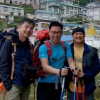
Above 5000 some problems with altitude sickness but Asal and Anil have reorganized the trek by changing the itinerary in a short time and with excellent results. We ended up to the EBC, Chola pass and Renjo pass. Spectacular landscape. Guide prepared and available. Perfect and flexible organization.
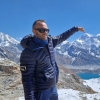
You can easily get your visa at Tribhuwan International Airport (TIA), Kathmandu. You need to have a passport size photo along with the original passport.
Yes, it is safe in Nepal. Over the past 10 years, Nepal has become the top traveling destinations in the world.
Spring and autumn are the best seasons to visit Nepal. According to data, Lots of travelers want to visit Nepal in September, October, March, and April.
It depends upon the routes that you are traveling. Teahouse has commonly used accommodation during the trek.
You can get the shower services but you have to pay. So, it’s up to your choice how many times you want.
Dal and Bhat is a commonly used food that Nepalese used. Besides that, you can find basic restaurant items like Momo, Chowmin, Noodle, and fried rice.
Yes, you can hire a guide and porter for your trek. An experienced guide can charge a high amount of cost for their service.
You can get communication facilities in lots of places during the trek. You can get wifi services for enjoyment.
Our guide can speak English, Chinese, Spanish, Hindi, and many more.
You must have insurance. if you get sick, accidents, loss of your bags or luggage even missing flights it will help to recover.
Yes, you will get the airport pick up and drop off services available. Our airport representatives will receive you at the airport and transfer you at the hotel in Thamel. Evening is free for you to explore the eateries and bars of the area. Our office will complete all your trekking formalities. Overnight in Hotel
Accommodation in Everest Base Camp Trek is in teahouse or lodge. In some places trekkers can get the attached bathroom but most of the time the room is in the general category and have common bathroom without private attached.
Hot shower is subjected to be paid extra. However, in some teahouses you can get free shower. But remember to consult with your guide before doing the shower
It is up to you to decide to do the trekking of your liking. Private or Group Trekking, the level of the services and the hospitality we provide is same. Therefore, choose according to your liking.
Yes, it is attainable by children but before the trek please mention the age of the trekkers to our travel planners so that we can amend the itinerary. For the children below 18 years old, it is recommended to have the guardian. However, we can arrange the trek or tour for kids too on the basis and guidance of their guardians
We can avoid the altitude sickness during the trek by following the instructions of the guide. You have to walk uphill or higher altitude slowly and uniformly. Please remember to have plenty of fluids either water or soupy food. Proper acclimatization in your itinerary can also help you avoid the altitude sickness.
Drink only boiled or purified water to avoid the risk of an upset stomach. You can also purchase bottled water (not recommended) or use water purification tablets.
Consult with your doctor and get vaccinations for tetanus, hepatitis A, and typhoid before traveling to Nepal.
The Everest Base Camp trek is typically 12-16 days, depending on the itinerary and acclimatization schedule.
Our maximum group size is 8 to 12 people. We also provide an assistant guide if the group includes 8 or more than that travelers.
